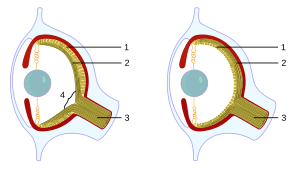Blind spot (vision) facts for kids

A blind spot is a small area in your vision that you can't see. It's like a tiny invisible patch in your visual field. This happens because of a special place in your eye called the optic disc.
The optic disc is where the optic nerve connects to your retina. The retina is the part of your eye that detects light. But at the optic disc, there are no light-detecting cells. So, any light that hits this spot can't be seen.
Normally, you don't notice your blind spot. This is because your brain is super smart! It fills in the missing information using details from the areas around the blind spot. Also, if you're using both eyes, the other eye usually sees what the first eye misses.
Most animals with vertebrate eyes, like humans, have this blind spot. But cephalopod eyes, like those of an octopus, are different. Their optic nerve connects in a way that doesn't create a gap in their retina, so they don't have a blind spot!
The first time someone officially noticed the blind spot was in the 1660s. A French scientist named Edme Mariotte discovered it. Before his discovery, people thought the spot where the optic nerve entered the eye would be the best at seeing. Mariotte's work showed this wasn't true.
In humans, the blind spot is located a bit to the side and slightly below the center of your vision. It's about 7.5 degrees tall and 5.5 degrees wide.
How to Find Your Blind Spot
You can easily find your own blind spot with a simple test. This test shows you how your brain fills in the missing parts of your vision.
| Try This: Find Your Blind Spot | ||||
|---|---|---|---|---|
| R | L | |||
Instructions:
|
||||
See also
 In Spanish: Punto ciego para niños
In Spanish: Punto ciego para niños
- Bias blind spot
- Filling-in
- Horizontal eccentricity

